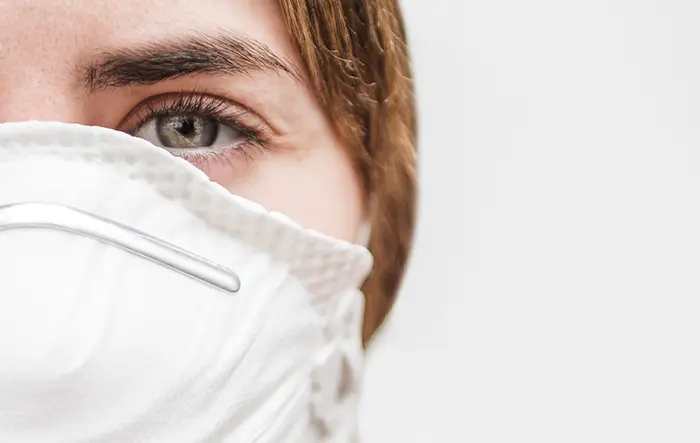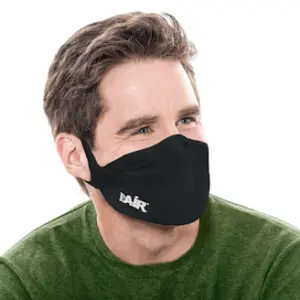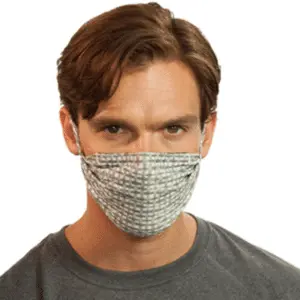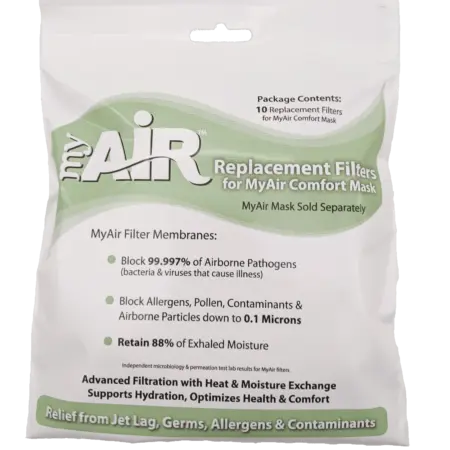The presence or absence of a nose wire or nose piece in a mask is a modern debate. A year and some change ago, virtually no one outside of the healthcare field would have had any significant opinion about it. These days, it seems everyone has their own, and the arguments can be fierce.
The truth is, there are a lot of significant pros and cons to that little nose wire, and there’s no one right answer. Some people like masks with them, some prefer masks without, and a lot of it comes down to other factors in your apparel.
The Pros of a Nose Wire
First up, let’s start by discussing some of the benefits of having a nose piece in your mask. These benefits largely apply no matter what kind of nose piece you have but may vary depending on the style and quality of the materials. Remember, as well, that different kinds of masks have different levels of fit on your face. A medical-grade N95 mask with a nose piece is tightly fitted and easy to wear, but irritating. A homemade cloth mask might be fitted or flat, pleated or cupped, and every style has its own variations. Here are the primary benefits.

Improved Fit. One of the keys to a mask working well is its fit. Full, certified N95s need to have a complete face seal, forcing 100% of your breath through the filter, and the nose piece helps keep that fit tight. Homemade masks may use a wire or nose strip to help with the fit. While a cloth mask could be unlikely to have a complete face seal, the nose piece can help improve the seal, particularly in the upwards direction. More on that in a moment.
Improved Comfort. While it might not seem like a metal strip across your nose makes a mask more comfortable, it actually can, depending on the style of the mask and its fit. Many cloth masks have the issue where they simply stretch a piece of fabric across your face, and that can put a lot of pressure directly on the bridge of your nose. A nose piece, however minimal, can spread out that force and help protect the bridge of your nose from the pressure. It can also help keep the mask in place, for people who have masks that slip or slide out of place.

Less Condensation. Perhaps the biggest benefit to having a nose piece is to reduce condensation. When you wear a mask, your breath has to go somewhere. With a medical-grade mask that has a full-face seal, or a full-on respirator, the seal forces all breath in and out through the filter. With a cloth mask, much of your breath leaks out around the edges of the mask. A tighter seal helps minimize how much breath escapes, but it’s a constant battle between the weave of the fabric and the tightness of the mask.
What it comes down to is fabric breathability, thickness, and tightness. A thick mask with a less breathable fabric will force more breath out around the mask rather than through it. This makes it easier to breathe but doesn’t protect you as much, since the air you breathe around the mask isn’t filtered.

The mask is still protective, don’t get us wrong. There’s a lot of difference between the air being pushed out around the edges of a mask and being aerosolized directly in front of you. Or, in the self-protective case, in this happening from others.
All this is to say that your breath travels through the path of least resistance. Many masks aren’t fitted to the face, so there’s a gap on either side of the bridge of your nose. Your breath simply travels through that gap. For some people this is fine. For anyone who wears glasses, this means your breath will instantly and inevitably fog up your glasses.
There are ways to deal with glasses fogging up, including glasses treatments, but the simplest option is to simply prevent your breath from pushing upwards. A metal nose piece or nose wire does this for you.
Higher Mask Quality. One final benefit is that the presence of a nose piece can indicate a mask of a higher quality level on average. This isn’t always the case – there can be cheap mass-produced masks with nose pieces and bespoke, well-crafted masks without – but comparing masks across the industry, it holds true in broad strokes. People who take the time to engineer masks with nose pieces typically have better construction than those who do not.
The Cons of a Nose Wire
Now let’s move on to the cons of a nose piece. There are a few more of them than there are pros, but they aren’t all deal-breakers. Several of them are relatively minor, and might not even affect your own decision.
More Expensive. Masks with nose pieces tend to be slightly more expensive than those without. There are two reasons for this; the masks take more labor to assemble beyond simple sewing, and the cost of materials increases when there’s a metal bit inside them as well. That said, a pack of 50 or 100 nose pieces is available on Amazon for $5, and people with direct connections to suppliers can get them even cheaper. That’s medical-grade nose pieces made out of aluminum with adhesive on them, as well. Many mask makers use makeshift metal instead. More on that later.

More Difficult to Repair. Masks occasionally need repair, especially if you’re wearing them every day. Different parts of the mask can wear out. The elastic bands can break or stretch out. The fabric can stretch. Seams can tear or come loose. Nose pieces, when flexed repeatedly, can break. If your metal nose piece breaks, it becomes useless at best, and potentially even actively painful to wear. You need to replace it, but it might be difficult or impossible to access the nose piece without tearing out stitches. If you need to repair your mask yourself, you will probably need to have sewing skills and equipment, and not everyone has that.
Can be Irritating. It’s entirely possible for a mask with a nose piece to be uncomfortable. Up above, we mentioned that masks with nose pieces can be more comfortable because the nose piece helps them fit better and distributes force. Conversely, a nose piece can dig into your nose and bite into the flesh, leaving a groove if you wear it too long. A lot of this depends on how tight the mask is and whether or not the nose piece is a wide, flat piece or a narrow, round piece. To a certain extent, it’s the difference between a flat metal piece and a wire, though there’s more nuance to it than that.

Harder to Clean. Masks with metal in them can be slightly harder to clean than plain cloth masks. A simple cloth mask can be thrown in with the rest of your laundry, either loose or in a simple container like a lingerie bag. You can also easily wash it by hand with soap and warm water, and let it air dry.
A mask with a nose piece needs to be treated with more care. A typical washing machine cycle with other clothes might flex and compress the nose piece, putting excess stress on it and risking it breaking. Nothing is worse than pulling a mask out of the dryer (or the wash, if you choose to air dry it) and finding it broken.
There’s also the issue that some metals can rust or corrode in the wash, and if whoever made your mask used the wrong kind of metal, your mask could have those issues.
Harder to Store. Just like the metal piece makes the mask more difficult to wash, it also makes it more difficult to store. You can’t just shove a mask with a nose piece in a pocket (though you shouldn’t do that with any mask), because you can bend, flex, and break the nose piece.

Unknown Quality. The largest issue with metal nose pieces is that you have no idea what the quality of the metal is. When you order a mask from Etsy or a bespoke web store, you never know what you’re getting. It could be a medical-grade aluminum nose piece, or it could be a bent paperclip.
Types of Nose Wires
In fact, let’s talk about this issue a bit more. The nose piece in masks varies wildly. There are a lot of different kinds of nose wires you might encounter.
- Medical-grade aluminum. These nose pieces are wide, flat, and have an adhesive back that allows them to stick to the surface of a mask. They can be ordered separately and attached to any mask or worked into the internals of a mask by the manufacturer. They don’t rust or corrode, and they’re flat so they don’t bite into your nose. The only downside is that aluminum is not super resilient, so frequent adjustments can break it.
- Crafting wire. Bead stores, craft stores, and fabric shops often have wires of various gauges available for purchase, and a lot of homemade masks use these wires. These can be anything from steel to copper to aluminum. They are often less comfortable but tend to be more resilient to repeated flexing. However, steel wires can rust, and copper wires can oxidize and leave green stains on your mask fabric.
- Pipe cleaners. In the early days of the pandemic, many mask makers were using any makeshift wire they could to add a nose piece to masks they sold. Pipe cleaners, with their fuzz removed, were a common option. These work fine and are nicely flexible while still being stiff, but they’re usually made of steel and rust very easily.
- Twist ties. These thin wires come in a wide variety of forms, from the thin paper-coated wires that ship with plastic bags to rubber-coated wires for industrial applications. Most of these are either too thin or too stiff to make good nose pieces, and they’re almost always made of a material that rusts.
We’ve also heard reports of people who find repurposed garbage, like bent paperclips, as their nose pieces. As always, buyer beware; make sure you trust whoever you’re buying a mask from to use a nose piece that can stand up to use while still maintaining comfort.
The Best of Both Worlds
So what is the best option? Truthfully, it’s difficult to say.
Ideally, the best choice is a mask with a nose wire, but one that is soft, flexible, stiff enough to form a seal to prevent condensation, but with enough padding around it to prevent it from digging into your nose.
You can also buy a cloth mask that doesn’t have a nose piece, and purchase an aftermarket nose piece to go on it. There are a lot of self-adhesive options that don’t require opening up your existing mask. There are a couple of downsides to doing this, of course. For one thing, the nose piece is visible on the outside of your mask (and you don’t want it on the inside, because it will be more irritating against your skin). For another, it’s rare to find those nose pieces in packages of less than 50, because they’re a bulk item, and you’re unlikely to need more than one of them a month unless you’re taking them off when you wash the mask.

Our masks have a thin wire with plenty of padding, which we have determined to be the best and most comfortable option for the majority of our customers. If you purchase one of our masks and don’t like the wire, you can always add one of your own. That’s the beauty of masks; they’re customizable with modern technology. You can change pretty much anything you don’t like about one, or hire someone with some basic sewing skills to do it for you.
What do you think? Do you prefer masks with nose pieces or masks without? There are people in both camps, and we’re curious; if you prefer masks without, do you wear glasses?





















0 Comments